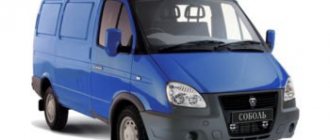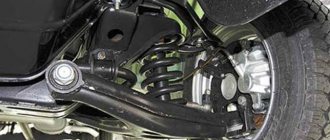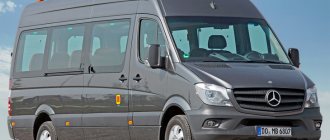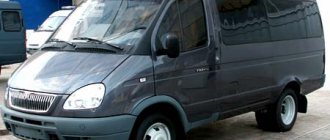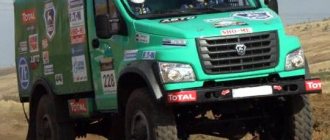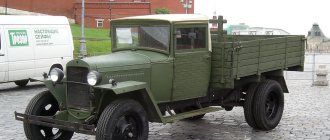Good afternoon, dear reader.
Vehicles in the Russian Federation are classified in several ways:
- by driving license category (A, B, C, D);
- by technical categories (M1-M3, N1-N3).
Moreover, the groups of vehicles in each of these classifications are their own.
For us, cars of the most common category B are of greatest interest.
These include vehicles of two technical categories: M1 - passenger (passenger) cars and N1 - trucks. Moreover, the traffic rules for small trucks of category B differ from the rules for cars.
In this article, we will figure out how to determine which category (passenger or truck) a particular vehicle should be classified into.
- Why do you need to know the type of vehicle?
- How to distinguish between a car and a truck in practice?
- How to calculate the type of car legally?
- Calculation examples for various cars: Example 1. Renault Logan car.
- Example 2. Cargo Gazelle van (GAZ 2705).
- Example 3. Gazelle cargo truck with body (GAZ 3302).
- Example 4. Volkswagen Amarok pickup truck.
- Example 5. Toyota Land Cruiser 200 (5 seats).
- Example 6. Toyota Land Cruiser 200 (7 seats).
Brief history of the model
Gazelle belongs to a series of Russian light-duty vehicles. The model range of the series begins its history in the summer of 1994, or more precisely, in July. The main production is concentrated at the Gorky Automobile Plant, but there are several more factories located on the territory of the former Soviet republics and abroad. They assemble cars from finished parts.
Classic Gazelle truck with kung
After 2003, a representative of the second generation came off the assembly line. Its differences from the first can be listed on the fingers of one hand. A new bumper, lighting fixtures and radiator grille were installed. Everything else is unchanged. Two and a half years later, the millionth Gazelle was released, which confirms the popularity of the model.
The second series was the leader on the Russian market until February 2010. It was at this time that the production of the Gazelle-Business model began. And 3 years later, in March 2013, the first Gazelle-Next rolled off the assembly line. From the old car she inherited only the gearbox, rear axle and frame; all other elements were updated.
In the autumn of the same year, the automaker presented the beginning of a new series “Gazelle - Business CNG”. This happened at the international exhibition GasSUF.
Towards the end of the year, the English agency INTERBRAND named the Nizhny Novgorod Automobile Plant the most influential Russian brand. Although in 2009 he took only 29th place.
Seven competitors of Gazelle-Next
The Russian automobile market can be called very saturated - buyers can choose products from dozens of manufacturers, both domestic and foreign. And it is diversity that often becomes an obstacle when choosing - it is impossible to find a vehicle that would be ideal in all aspects. It takes a long time to compare different options based on many parameters, doubt and waste a lot of time.
If the ideal is unattainable, then when buying it is best to focus on a car with balanced characteristics. This is exactly what its creators intended the Gazelle-Next to be - it was developed as a commercial vehicle that exactly met the needs of the Russian market. In order to find out whether this is so, it is worth knowing which cars the domestic product can compete with by selecting alternative options based on various characteristics.
No. 1. IVECO Daily
The Italian Car and Gazelle Next are among the few vans that can boast a very large cargo compartment capacity. For a Russian vehicle it is 13.5 cubic meters, while for IVECO in the version with the highest roof, medium wheelbase and extended rear overhang it is 13.4 cubic meters.
Such indicators allow cars to easily cope with the transportation of bulk cargo that has a relatively low specific gravity. Such characteristics make them an optimal option for use in grocery retail, as well as for delivery services. In addition, the largest modifications of vans are often purchased by construction and installation teams involved in finishing work, insulating houses and other operations. The advantages of a larger volume body can be listed almost endlessly, but in general we can conclude that it makes the car universal and suitable for use in several dozen industries at once.
An Italian competitor with a similar body volume has its advantages, but before choosing it, you should take into account the cost of such a vehicle - about 2 million rubles in the basic configuration. At the same time, the all-metal Gazelle-Next van costs the buyer almost 2 times less. It is worth noting the fact that most IVECO Daily supplied to our country with such a body have a total weight of 5.2 tons - this automatically imposes a restriction on entry into the center of large cities, and also requires obtaining a class C license.
No. 2. Mercedes Sprinter
In construction practice, it is often necessary to transport very long but light objects - for example, cornices, metal profiles and guides, as well as elements of finishing structures. When it comes to cargo with a length of about 5 meters, then most standard vans are powerless - their owners have to rent larger vehicles, or leave the body doors open, violating the Rules and endangering others.
But this problem does not apply to the Mercedes Sprinter and Gazelle Next - they are easily able to cope with these tasks. The German car, in a version with a maximum wheelbase length and an increased rear overhang, can accommodate structures up to 4.7 meters. But Gazelle has surpassed this recognized leader of the European market - a folding hatch in the partition with the cabin allows it to transport 5-meter loads! This means that there is no need to hire heavy transport, spending huge sums on its rental, fuel and loading and unloading operations.
This feature makes the vehicles suitable not only for builders, but also for service companies or advertising agencies - long bodies are convenient for transporting multi-section ladders and stepladders, as well as structures to be installed. In addition, the large maximum cargo length will certainly be of interest to specialized enterprises that sell and deliver large-sized products.
Mercedes has gained popularity in Europe thanks to its original design and premium equipment. However, for the Russian commercial vehicle market this car looks too luxurious - the cost of the reviewed version starts from 2.8 million rubles and reaches 3.4 million! At the same time, the basic version of the all-metal Gazelle Next costs 1.1 million. It is worth noting that the Russian car meets modern standards of comfort and safety, and also has excellent equipment.
No. 3. Renault Master
Modern commercial vehicles are almost always equipped with fuel-efficient, highly efficient diesel engines. This allows you to keep operating costs low while maintaining excellent dynamic characteristics of the vehicle. Gazelle-Next and Renault Master are no exception - their average fuel consumption per 100 kilometers fluctuates around 10 liters.
However, it is worth paying attention to the carrying capacity of both comparison participants. The Gazelle can accommodate up to 1.5 tons - and this will not create an increased load on its components, since the all-metal van has received a number of design changes that increase its reliability and endurance. The French competitor takes on board only 1.1 tons - this limits its use in areas such as construction, delivery of industrial goods and courier services. In addition, this means that the owner of such equipment will be forced to spend more money on moving one ton of cargo. Of course, in the Renault model range there is a Master with a larger load capacity, but we are talking about front-wheel drive vehicles with a small body volume, or vans with a gross weight of more than 3.5 tons, belonging to class C.
French commercial vehicles are often called one of the most affordable on the European market, but compared to the Gazelle, even it requires much more capital investment. The base price of the Renault Master H3L3 is 1.7 million rubles - and the initial configuration is even inferior to its Russian counterpart in terms of equipment.
No. 4. Ford Transit
An important parameter for a cargo van is the loading height. If its value is small, it is possible to place a load inside or remove it without the use of special equipment. Otherwise, you will have to use a forklift - while such equipment is not present in every enterprise.
Both Gazelle-Next and Ford Transit provide easy loading and unloading operations - the body floor in both vehicles is located at a height of just over 700 mm. This indicator can be called perfectly balanced. It allows for manual unloading of materials on construction sites and in small businesses, and also provides ease of use of the ramp in a large warehouse or production facility.
Among the advantages of a Ford van assembled in Germany are low fuel consumption and excellent equipment. However, some savings during its operation are completely offset by the higher cost of the initial configuration. You can buy such a car for 1.8 million rubles - and it will not have body upholstery and lifting eyelets, which are available to all buyers of an all-metal van from GAZ.
No. 5. FIAT Ducato
The turning radius indicator actually reflects the maneuverability of the machine and its suitability for use in urban environments. If its value is large, it will be very difficult to operate the car in the delivery service or in the transportation of service equipment. It will not be able to drive into tight yards or turn around on narrow roads, and will also make parking incredibly difficult.
For owners of FIAT Ducato and Gazelle Next, this problem is irrelevant - a turning radius of 6.5 meters makes driving a commercial vehicle very easy and convenient in any conditions. Among other advantages, this greatly simplifies access to the loading ramp of a large production plant or logistics center. Accordingly, high maneuverability makes the car universal, allowing it to be used in a variety of areas.
The FIAT with a medium wheelbase has the same turning radius as the Gazelle Next, which has a much smaller body capacity - from 10 to 11.5 cubic meters. At the same time, the buyer should count on a higher cost of the vehicle in the initial configuration - at least 1.65 million rubles.
No. 6. Volkswagen Crafter
Ground clearance of 170 mm is the optimal indicator for a commercial van that will be used on roads. This indicator makes the bottom practically invulnerable to stones, speed bumps and other road obstacles. At the same time, it does not force the loading height to be increased excessively, reducing the ease of use of the machine.
This is precisely the indicator offered by Gazelle-Next and its German competitor Volkswagen Crafter in the L3H3 version, which approximately corresponds to the dimensions of Russian commercial vehicles. These machines can be operated even in conditions of poor quality road surfaces - even deep holes and various obstacles will not cause damage to vital components. In addition, such cars are able to drive onto a curb, overcome a particularly high speed bump or a poorly organized railroad crossing. It is also worth noting that the reinforced suspension of both vans allows you to do without significant sagging even under heavy loads.
The Volkswagen Crafter is built on the same platform as the Mercedes Sprinter, although it has simpler equipment. But the use of general technical solutions affects its cost - it is not possible to buy a long-wheelbase version for less than 2.2 million rubles.
No. 7. Mercedes Sprinter
Using alternative fuel allows you to get considerable savings - the cost of methane is 2 times less than that of gasoline or diesel. At the same time, the infrastructure for gas-powered vehicles is quite well developed in Russia - you can find a compressor filling station near any large city. That is why enterprises that want to reduce their operating costs often purchase such equipment.
Gazelle-Next can be supplied in a gas-cylinder version or with a diesel engine, which makes it easy to equip the machine with additional equipment for running on alternative fuel. Among foreign competitors, Mercedes Sprinter is one of the few to offer this option. The German manufacturer's lineup includes a car with a 1.8-liter dual-fuel engine that produces 156 horsepower on gasoline.
Such machines do not require expensive specific maintenance. When using factory-installed equipment, they can be repaired at branded service stations without any restrictions. At the same time, the cost of their operation, and, accordingly, of each transported ton, is reduced by almost 2 times.
It should be noted that the Mercedes Sprinter, capable of running on methane, is available only in a small-sized version - with a body volume of up to 11 cubic meters and a load capacity of 1.1 tons. Moreover, the cost of such a machine is quite high - at least 2.1 million rubles. At the same time, a converted Gazelle with a dual-fuel engine can be purchased for 1.3–1.4 million rubles.
Leader in many characteristics - Gazelle-Next
Having examined the foreign competitors of the Gazelle-Next, we can make sure that the domestic car is not inferior to them in most parameters. It really has very balanced characteristics that meet the needs of the Russian market, as stated by its creators. At the same time, the car has a modern interior and cargo compartment, is equipped with a comfortable driver’s workplace and meets all safety standards. In addition, the improvements made during the next update made the car very reliable - when used, it will not cause significant problems and upset the owner with high costs.
GAZ-3302
GAZ - 3302 Gazelle - an onboard vehicle with a carrying capacity of 1.5 tons. Produced since 1994. It was restyled several times (2003 and 2010). This model is unique with its loading height of one meter. This level was achieved thanks to the installation of low-profile tires. The front brakes are disc brakes, manufactured under the control of Lucas.
In the summer of 1995, the automobile plant launched a small batch of GAZ-33027 all-wheel drive vehicles. They were intended for use on rural dirt roads and even off-road. 7 years later, in 2002, a new model rolled off the assembly line - 330202.
This is what the modification of gazelle 3302 looks like.
Its difference is the elongated frame. Initially, this development was intended for use as tow trucks and auto shops, but soon other models on this frame appeared.
GAZ-2705
Trucks and utility vehicles of this series have been produced since 1995. The carrying capacity of the “Van” modification is 1350 kg and there are only two seats for passengers. Models with the Combi index have an additional partition with a passenger seat. They are inferior in carrying capacity - no more than 1 ton - but can accommodate 6 passengers. Most special vehicles are produced on the basis of various modifications of the GAZ-2705:
- armored vehicles for collectors;
- auto laboratories;
- ambulances;
- special vehicles of the Ministry of Internal Affairs.
The installation of additional equipment is carried out by contracting companies that specialize in this particular area.
Classic appearance of GAZ 2705
Currently, after another restyling, this series is called “Gazelle Business” and has 8 different modifications and configurations. The cost starts from 740,000 rubles.
Why do you need to know the type of vehicle?
There are several reasons why car owners want to understand the type of vehicle:
- The traffic rules for cars and Category B trucks are different.
- Transport tax for cars and trucks is calculated using different formulas. And the car owner wants to understand whether the tax office made the calculation correctly.
- The cost of some toll services (toll roads, bridges, ferry crossings) differs for cars and trucks.
GAZ-3221
The start of production dates back to March 1996. GAZ-3221 is a series of minibuses with 8 passenger seats. Gradually, designers are improving its characteristics.
- 1996 – all-wheel drive modifications are produced;
- 2003 – a new interior ventilation and heating system was developed and installed;
- 2005 – ABS (anti-lock braking system) was introduced;
- 2008 – a specially equipped children’s minibus was put into operation, with all the relevant requirements for transporting children.
How to calculate the type of car legally?
So, let's assume that you need to find out the type of car. There may be various reasons for this:
- The driver believes that the information included in the registration certificate was entered in error . This happens in practice, although not very often.
- The field on the certificate of registration has the ambiguous meaning "other".
- The car was recently imported into Russia from abroad and documents for it have not yet been received. The car owner wants to understand in advance which category will be assigned to the car.
Let's consider paragraph 1 of the note to Appendix No. 1 to the technical regulations of the Customs Union “On the safety of wheeled vehicles” (TR CU 018/2011):
1. A vehicle with no more than eight seats, excluding the driver's seat, intended for the carriage of passengers and goods, belongs to the category:
- M1, if the product of the number of passengers provided for by the design by the conditional mass of one passenger (68 kg) exceeds the estimated mass of cargo transported simultaneously with passengers;
- N if this condition is not met.
A vehicle designed for the transport of passengers and goods, having, in addition to the driver's seat, more than eight seats, belongs to category M.
This paragraph tells us the following:
- A vehicle is considered a passenger vehicle if the estimated weight of passengers exceeds the estimated weight of cargo.
- A vehicle is considered a cargo vehicle if the estimated weight of cargo exceeds the estimated weight of passengers.
Let's figure out how to calculate this information based on the registration certificate or any other document containing information about the permissible maximum weight (RMM), unladen weight (MLN) and the number of passenger seats (NCS).
1. Write down the values of RMM (field “Allowed max weight, kg”) and MBN (field “Weight without load, kg”).
2. Record the number of passenger seats of the HRC. The driver's position does not need to be taken into account.
For example, for a standard five-seater car, CFC = 4.
3. Calculate the estimated passenger mass (RPM) using the following formula:
RMP = HRC * 68
4. Calculate the estimated cargo mass (RMG) using the following formula:
RMG = RMM - MBN - RMP
5. Compare the obtained values of RMP and RMG.
If the passenger mass of the RMP is greater, then the car is a passenger car . If the mass of the RMG cargo is greater, then the vehicle is a cargo vehicle .
GAZ-322132
The most striking model of all of the above, and in the literal sense of the word. This is a regular minibus with a side door. Its production began in August 1996. It differs from the basic configuration of the GAZ-322132 only in the layout of the seats and the presence of racks for passengers.
Since 2005, the series has been equipped with a new interior heating system, as well as ABS. From the same year, bright yellow coloring was carried out at the manufacturing plant.
Gazelle-Next
In 2012, at the Moscow Motor Show, representatives of the Gorky Automobile Plant showed their new development, Gazelle-Next. It turned out to be practically a new car. From its predecessor it inherited only the frame, rear beam and gearbox. Six months later, mass production of cars in this series began. The power units installed on the new Next have also changed.
Gasoline engines are available only from UMZ, and diesel engines from Daimler and Cummins. Overheating is now virtually eliminated thanks to the new large radiator.
This guarantees that the car will not boil over in long city traffic jams. Even the simplest, basic equipment has power steering (power steering).
Layout and overall dimensions of the Gazelle-Next truck
When creating it, the designers took care of the safety of the driver and passengers. The model is equipped with airbags, although not in all trim levels. The new seat belts, produced specifically for the new car, will surprise you with their quality.
Not a freeloader, but a partner
Being an assembly contractor, GAZ is less dependent on the immediate demand for cars: as many as ordered, as many are produced, if you please, pick them up. The main thing is to ensure proper quality. After all, joint ventures also produce many components for GAZelles. Remember the ever-flowing Gazelle radiators? The creation of a joint venture with T.RAD (a Japanese manufacturer and main supplier of radiators for Toyota) made it possible to solve the problem.
The quality control system for the GAZelle conveyor was once borrowed from Toyota - even during the launch of Cyber. Something was later adopted from Daimler: in the same workshop on the next line they assemble the Mercedes-Benz Sprinter Classic. In addition, two vehicles are randomly selected for audit every day. The cars are inspected and then driven for about 80 km, identifying extraneous noise and other possible problems. Detected defects are eliminated using the “conveyor” method - so that the same flaws do not appear on other machines.
The joint venture with the Belgian company Bosal provides all GAZ conveyor lines with exhaust system parts.
The joint venture with the Belgian company Bosal provides all GAZ conveyor lines with exhaust system parts.
Every day at the end of the working day, all dealers send information about the repairs performed to GAZ headquarters. The factory workers analyze it and, if some new serious defect emerges, they go to the dealer to study the problem.
However, the lesson with the Volga showed that build quality alone is not enough. The car must match the times. For example, while the all-metal body of the GAZelle Next was being developed and launched, what seemed then to be a temporary model was put into production: a frame bus on the chassis of the same Next. Moreover, they offered a version with standard gas equipment and a dual-fuel (gasoline/gas) EvoTech A275 engine with a displacement of 2.7 liters. The car fits into the market so well that people are still buying it.
